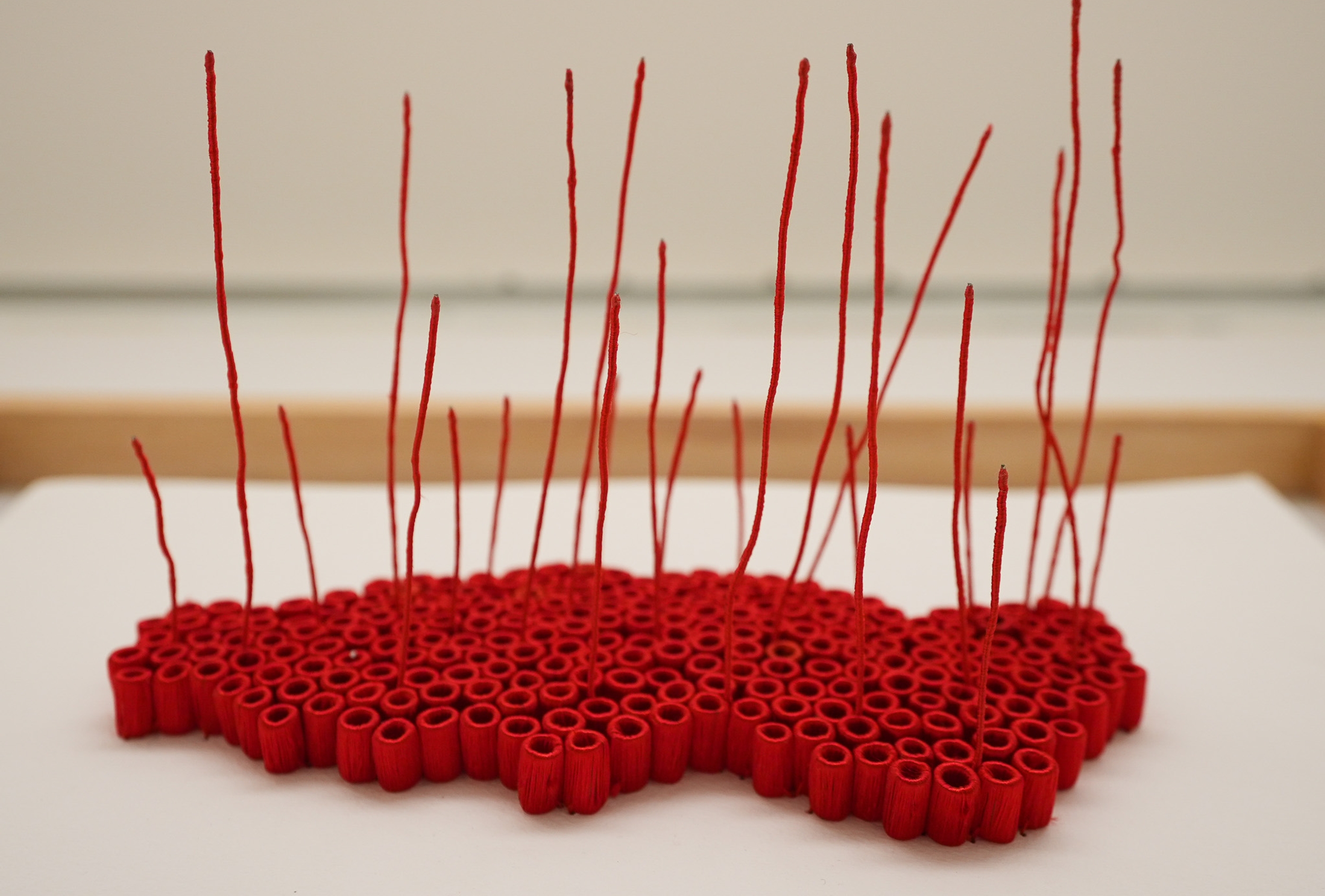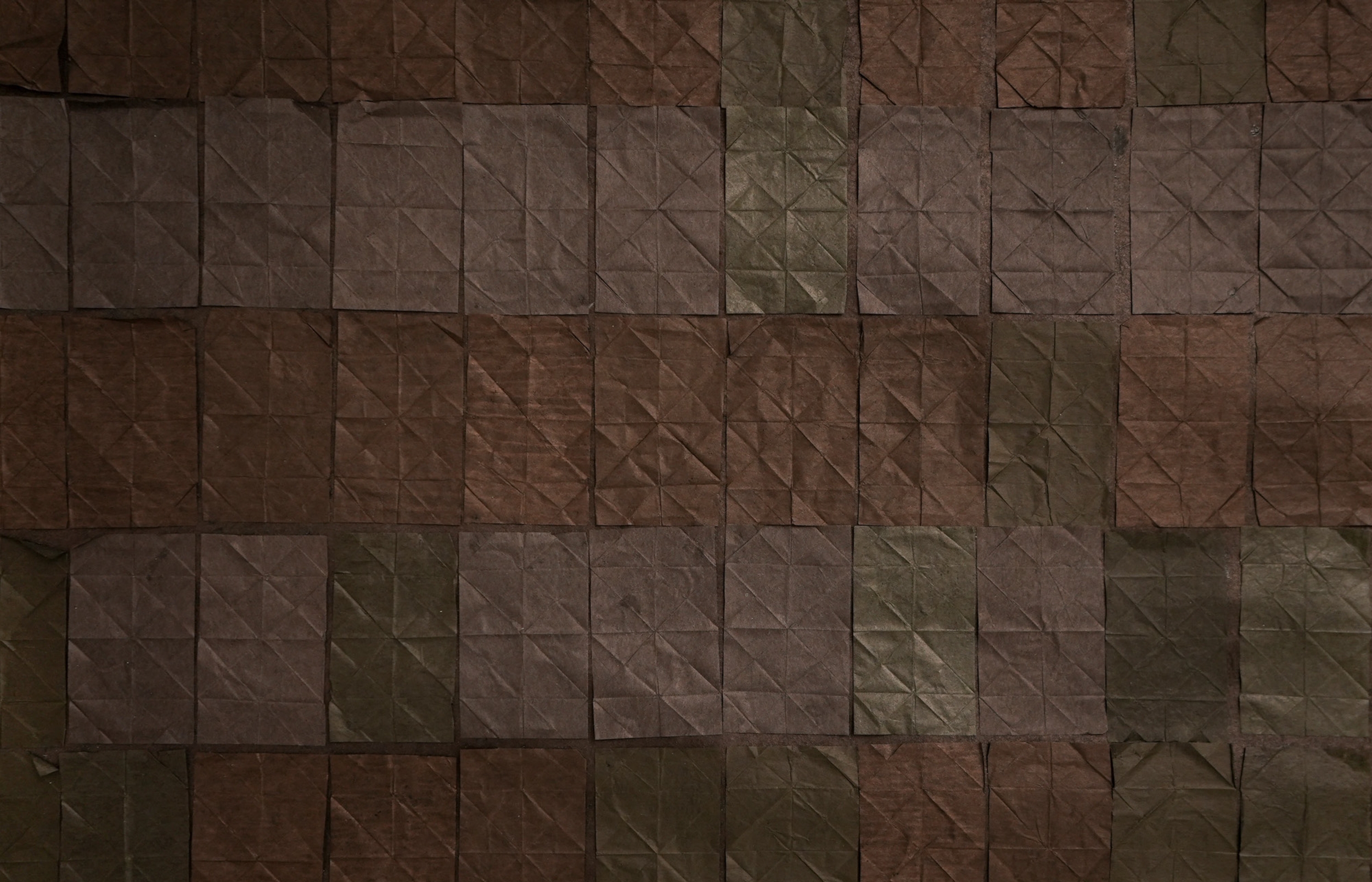Body
Performing Bodies: Gallery Selection for Lakum Artspace
Taking place as part of Misk Art Week, Performing Bodies features six female artists from the region who experiment with various folk-craft techniques and delve into ancestral relationships, practices, and rituals.
The act of creation is a performative act; it is a dynamic choreography composed of a series of precise movements, sequences, flows, and repetitions. At the center of craft-making is the human body, where the eye, hand, leg, and mind ebb and flow in a metronomic and meditative manner as a piece is being constructed or woven together. It is at once an organized process, and a meditative, liberating flow.
For thousands of years, acts of weaving, knitting, folding, stitching, embroidering, and crocheting have played a vital role in cultural and social identity. Textile- and tactile-based crafts have traditionally been a form of social bonding amongst the predominantly women who practiced it. Generation after generation, these practices have been handed down, performed, shared, and refined to become rituals that are personal and collective, private and public, and intimate and shared.
Within the flourishing contemporary art and design disciplines in the Middle East, we see an attempt to reconcile ruptures between past and present in the form of an inter-generational investigation into practices that link the human body with craft.
The artists in this exhibition experiment with various folk-craft techniques in which performative gestures create and re-create understandings of memory, intimacy, and ritual, and meditate on the natural cycles of the earth; the rising and setting of the sun, the change of the seasons, the movement of the tides, and cycles of life and death, loss and gain, decay and rebirth.

Dina Haddadin — How to disappear, 2022.
This piece is envisioned as a collage of maps; some fictional and others real. Each stitch is a plot or corner-demarcation. By making marks repetitively, the artist plays on the concept of rooting and uprooting, place and placelessness, connections and disconnections — all physically orchestrated with the thread and the hand.

Dina Haddadin — How to disappear, 2022. Detail.


Beyond sentimental notions of nostalgia and preservation, craft in this sense becomes a transcendent, conscious, and intentional process. Within the works is a living, active, and present force; a vehicle through which we come to understand and define our present-day spiritual and cultural identities.
The crafts showcased in the exhibition had historically been developed by women and were linked to a sense of bonding where techniques and rituals were passed down through generations. The artists used weaving, knitting, folding, stitching, embroidering, and crocheting to examine the rich culture and social identity of the Middle East.
The art techniques highlighted in the exhibition brought the creative minds of artists together, playing a vital role in unity that emphasized the cultural and social identity of the region.

Dina Haddadin — Utopian Island in a Flat City, 2019.
The research-based artistic project titled "Island 861" sheds light on the Hay al Qaysieh neighborhood in Wadi Abdoun, Amman: a marginalized “informal” settlement that was demolished to open up the way for a new high-rise district.
The base of the artwork is a computerized weave of an image that was used to market the new development project, used on city billboards and advertisements. It promised citizens the utopian dream; a 300-million-dollar investment, which was never realized.

Nojoud Al-Sudairi — Landscape Triptych, 2019.
These woven tapestry fragments were made as part of a larger body of work that traces the landscape of Wadi Hanifah. The three fragments stitched on stretched linen are not a depiction of the Wadi itself, but rather attempt to absorb and abstract elements of its condition. The work reads as an extension to native weaving practices in the region, and draws reference to the temporal quality of textiles and the erosion of the landscapes from where they are contextualized.




Nojoud Al-Sudairi — Ghuwaifat, 2017.


Ghizlane Sahli — La Mer(e), Origine du Monde (MOMD), 2022.
With the help of ancestral techniques and the know-how of the women artisans who surround her, Sahli embroiders, sculpts and draws a parallel between the vastness and complexity of the sea, and the symbolism of motherhood, creation, life, and the divine feminine.
The three-dimensional embroidery is generated by the same circular, meditative and infinite gestures of weaving thread around waste objects; copper wire, transparent plastic tubes, pieces of used CDs, wool, burns from fire, or even ink dyeing, are all part of a meticulously orchestrated internal metamorphosis. The result is a theater of forms, materials, scales, and volumes.

Ghizlane Sahli — MOMD, 2022. Detail.


Afshan Daneshvar — Untitled, 2022.

Sun, the eternally victorious, the brightest of all
It shines at its designated time, every single day
Even in the darkest moments of human history
In everlasting repetition, Day follows Night
The finest renewal
It offers us hope. It conquers the darkness.
I envision the battle between light and darkness taking place on my paper.
The everlasting victor is the sun.
— Afshan Daneshvar

Afshan Daneshvar — Six feet far, 2020. Detail.
Reflecting on the time when her grandmother departed this world, Afshan plays with the measurement of six feet; the depth of the grave, the recommended separation for social distancing. Six feet is the distance between existence and nonexistence.
Inscribed with calligraphy, the light tracing paper carries the traditional Quranic blessings uttered by the artist's grandmother. The paper strips containing her words were braided to make a paper carpet carrying similarities with Islamic illuminated scripts, especially in the central medallion pattern (toranj).
While Persian carpets are generally woven in standard sizes, this paper ‘kenareh’ (long runner) re-visits the Yalameh pattern from the South Central part of Iran to become a contemporary carpet, weaving the pattern with words.

Afshan Daneshvar — Untitled from Boat Series, 2022.

I filled the six-foot distance between me and you
with an ethereal Kenareh of her prayers and blessings, to hope for better times.
— Afshan Daneshvar

Afshan Daneshvar — Untitled from Boat Series, 2022. Detail.
The Boat Series comprises thousands of small origami boats pasted side by side across various canvases. Observed together, individuality is lost. Instead, a fluid motion engulfs a subtle geometric form. While there is movement, its direction remains ambiguous. Each boat is an embodiment of human presence floating in the sea of life.


Hadeyeh Badri — Body 1 and Body 2, 2018.
Fiber practices offer a language that unites gesture, touch, memory, choice and ritual. Weaving points at permeability; a deliberate coding and re-coding. There is control, but also, much resignation to the loom. An inquiry into trauma gives birth to work that speaks to many aspects of the human condition: illness, grief, mortality, ethical questions about hospitalization, etc…
In Body, an invisible body in pain wants to remain in sight: she does not retreat, she confronts the beholder. She is emulated by broken surfaces, fragmented colors, a figure (or lack thereof), a sag, and hairy, bristly fiber-y texture. This emulation, however, often points at the failure in articulating pain. The traumatized body, the original site, stretches herself on the ground, and takes up space.




Hanaa Almilli — The echoes of my alienation, 2019.
Ghorba; a word in Arabic that describes alienation, culture shock, loneliness, and homesickness. The act of embroidering, dyeing, and shaping textiles as if they were self-portraits becomes an act of shaping a home and one's own geography.

Hanaa Almilli — The echoes of my alienation, 2019. Detail.
